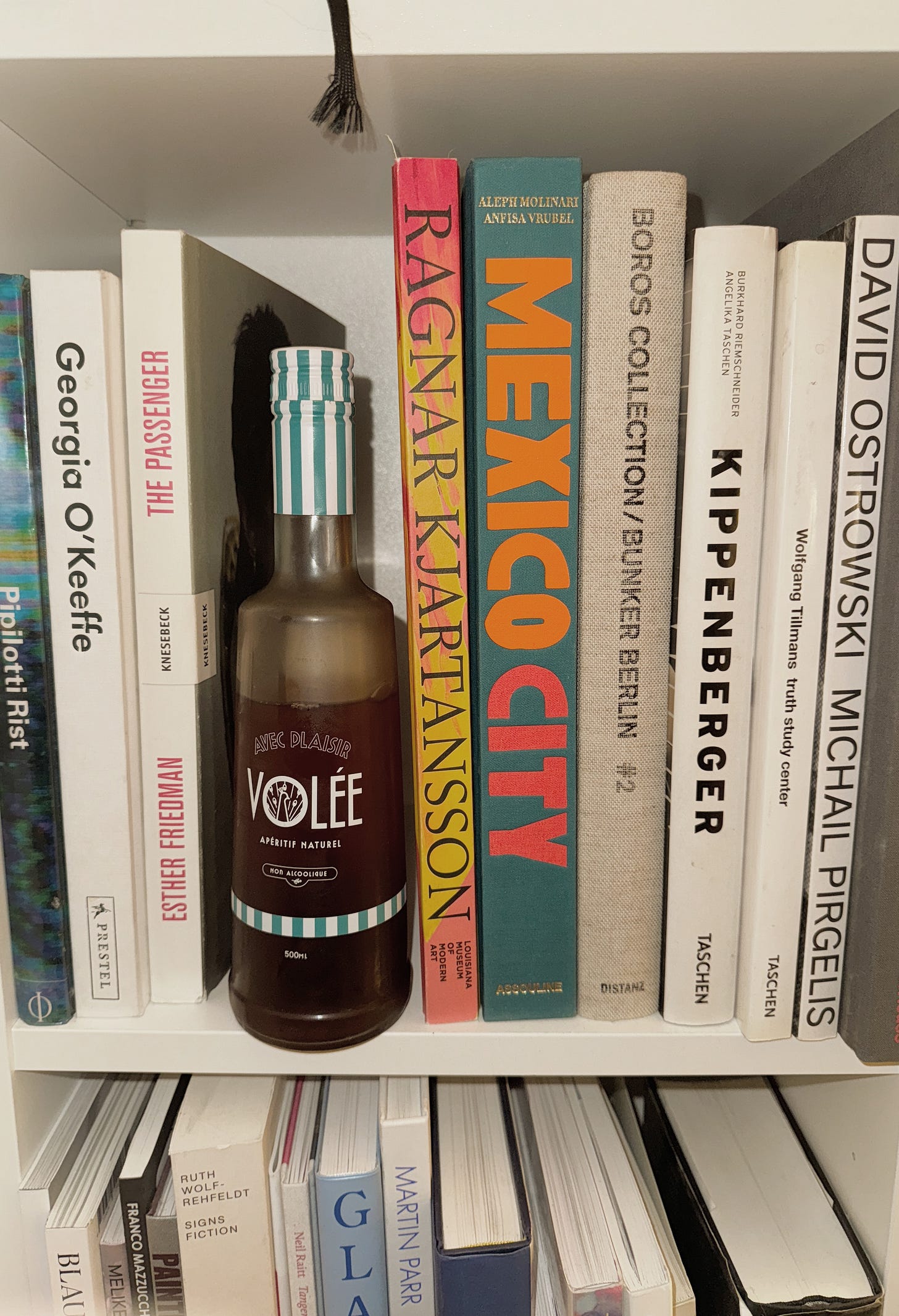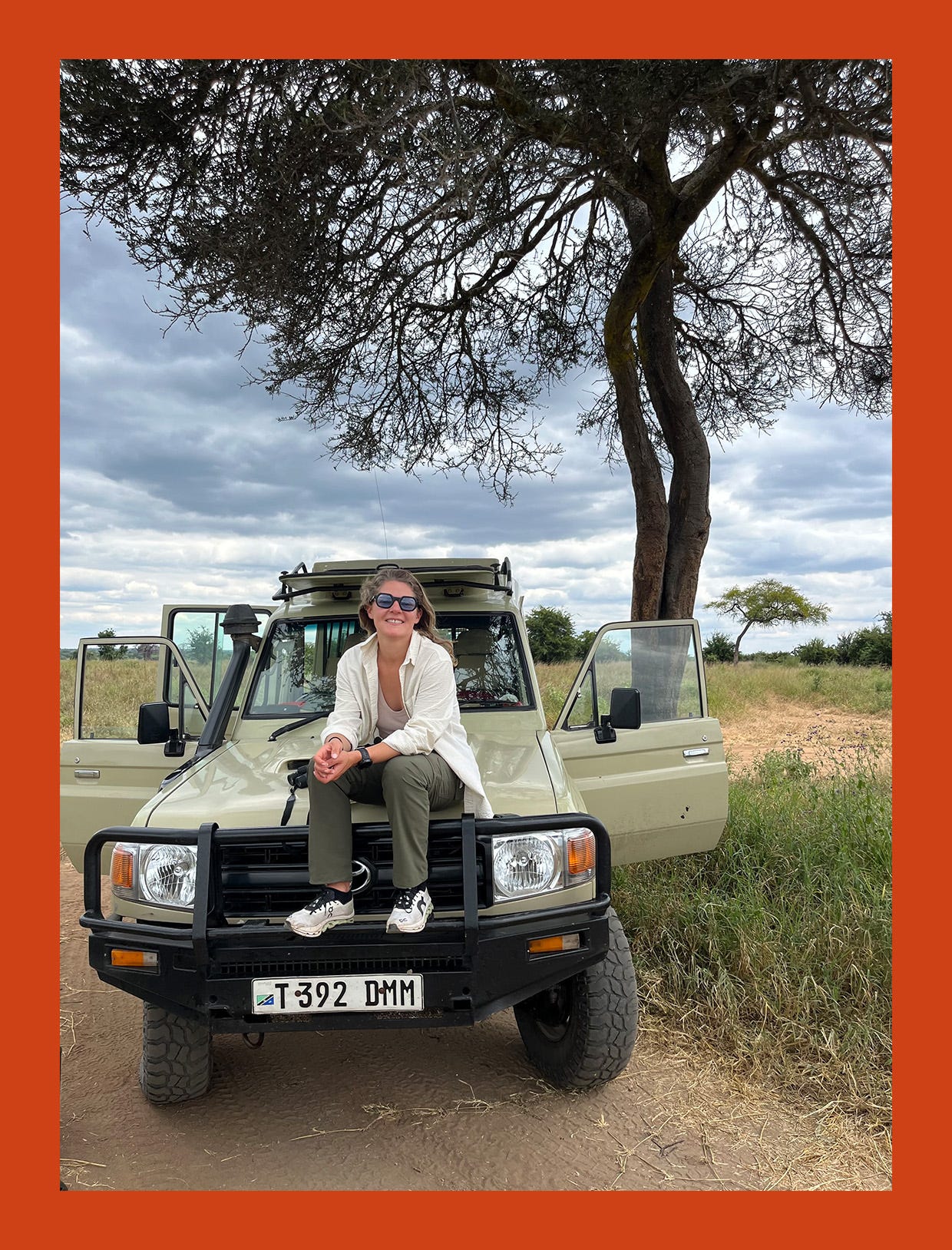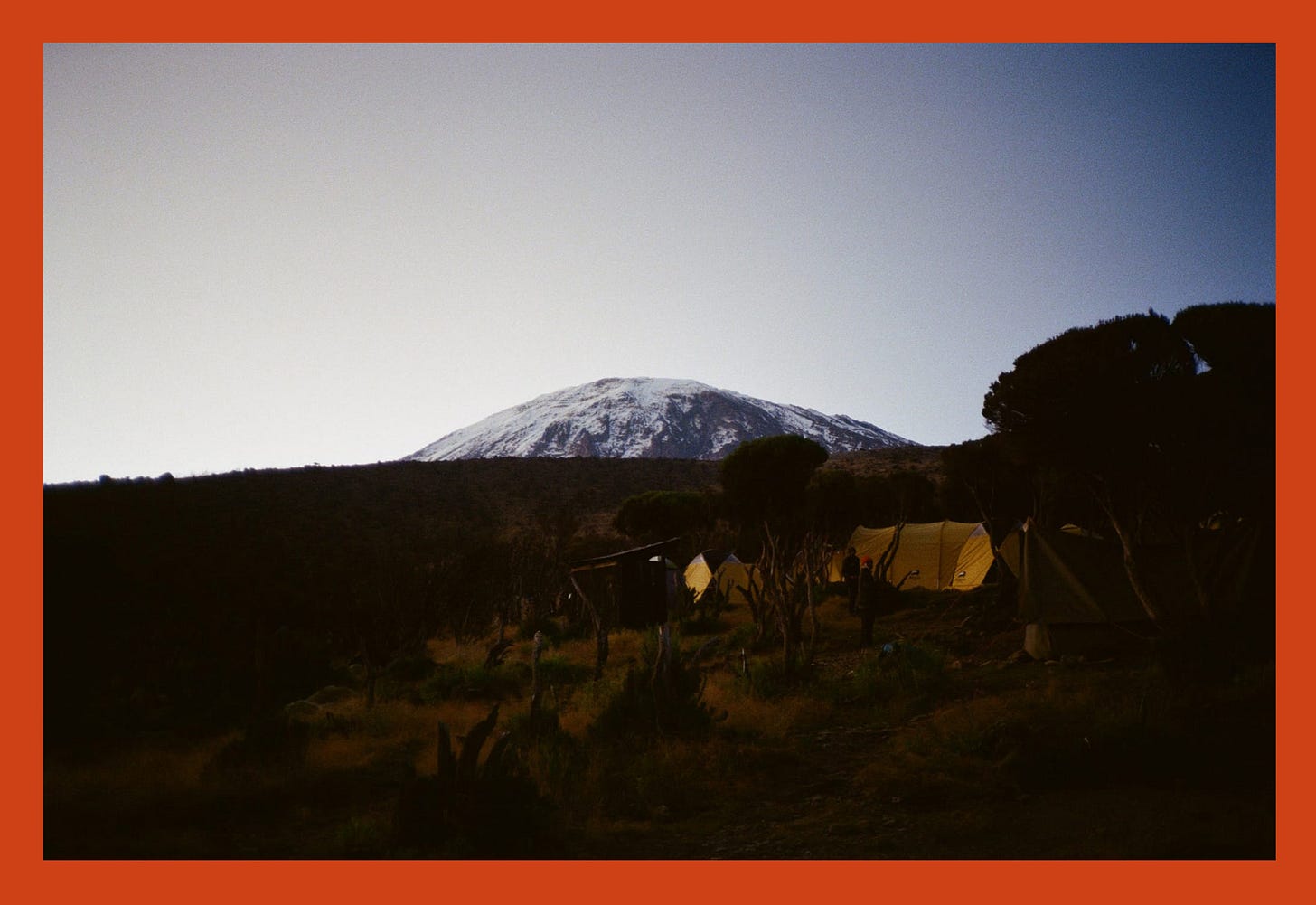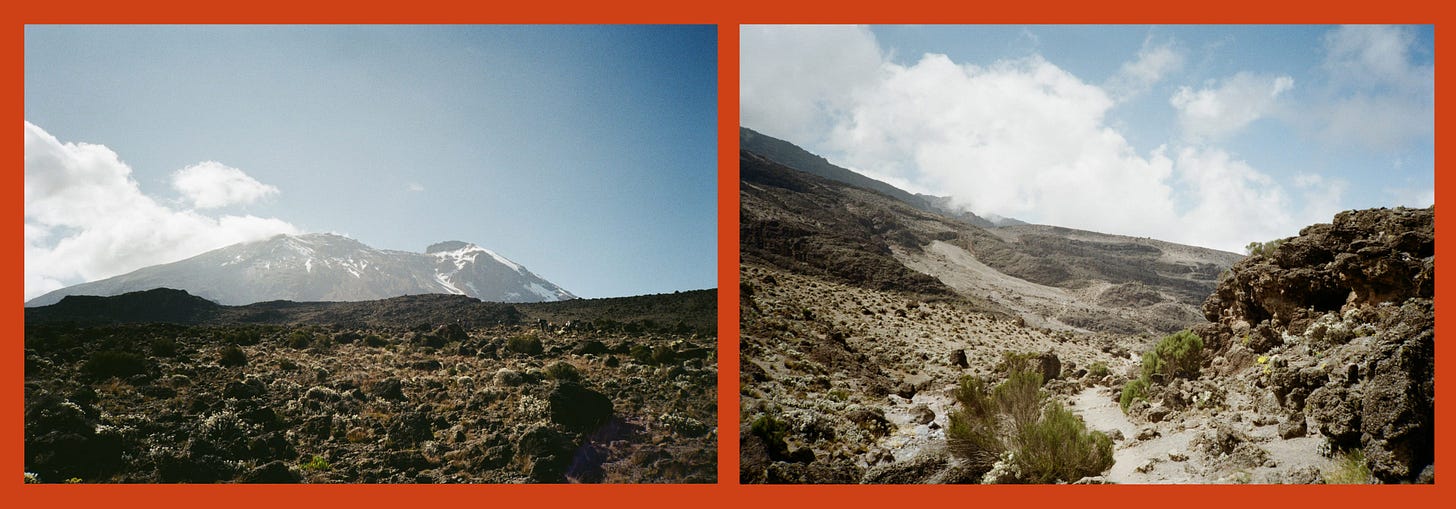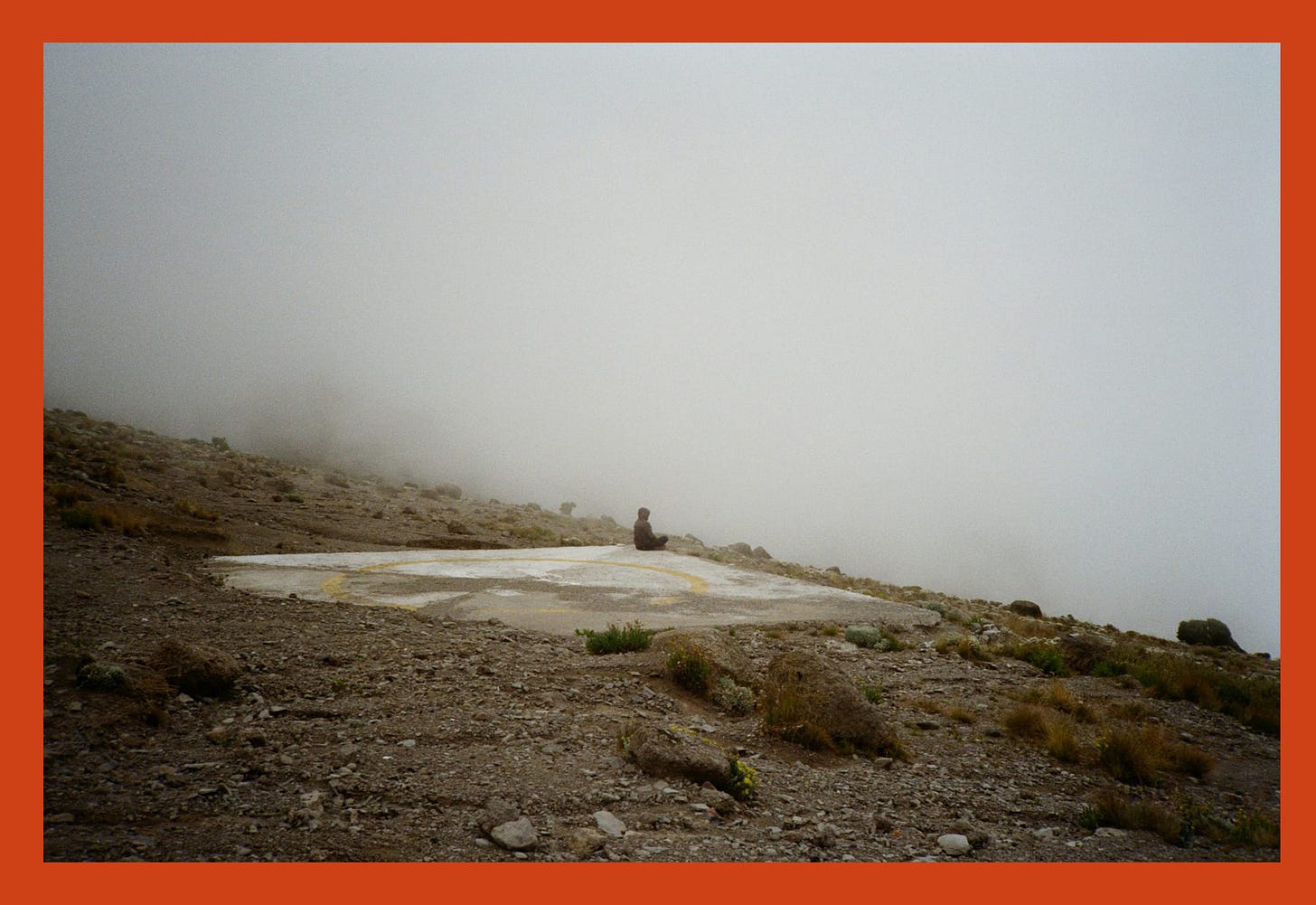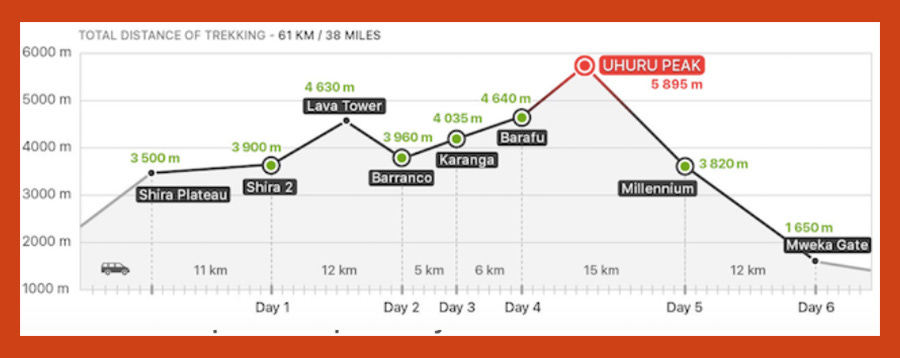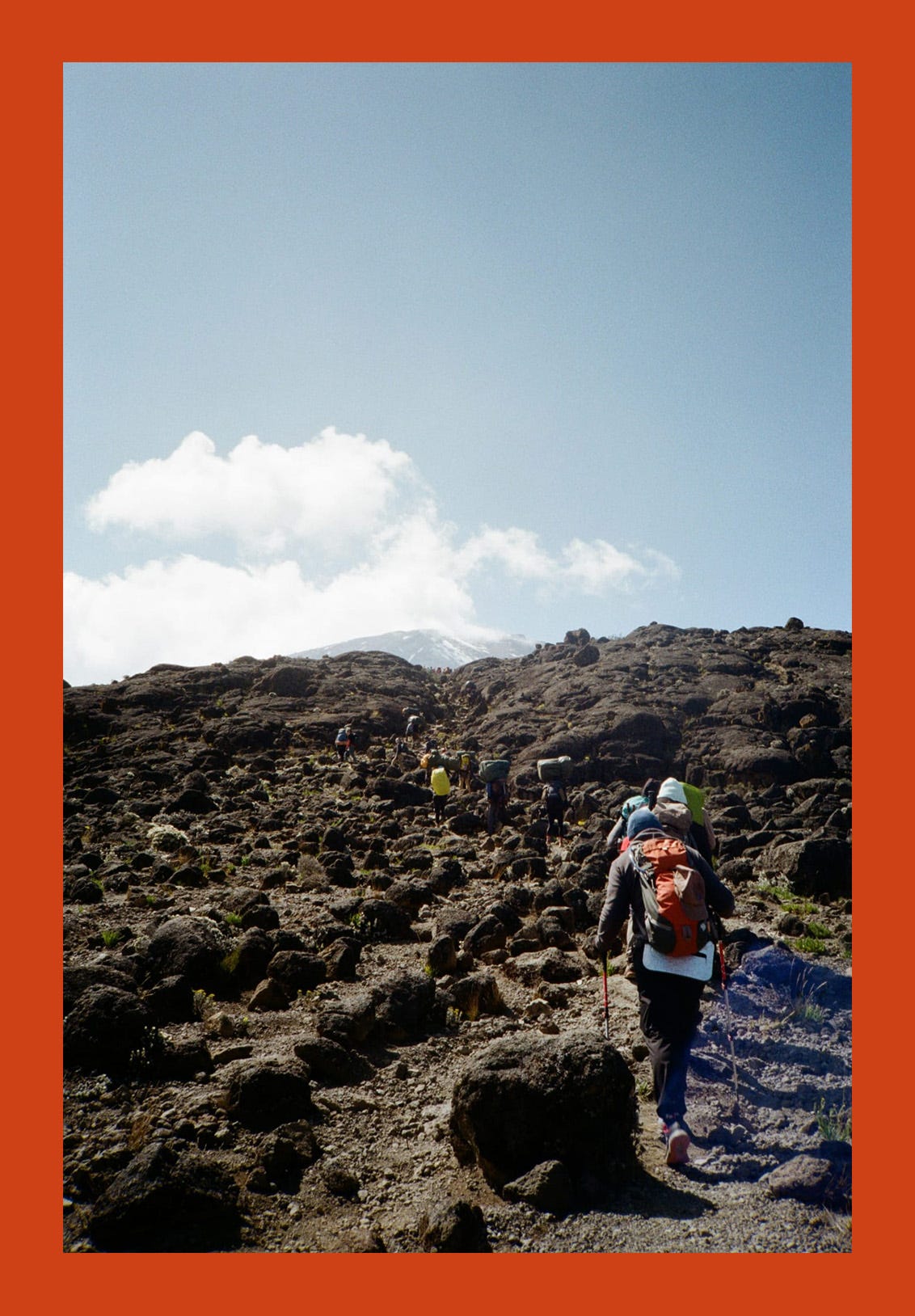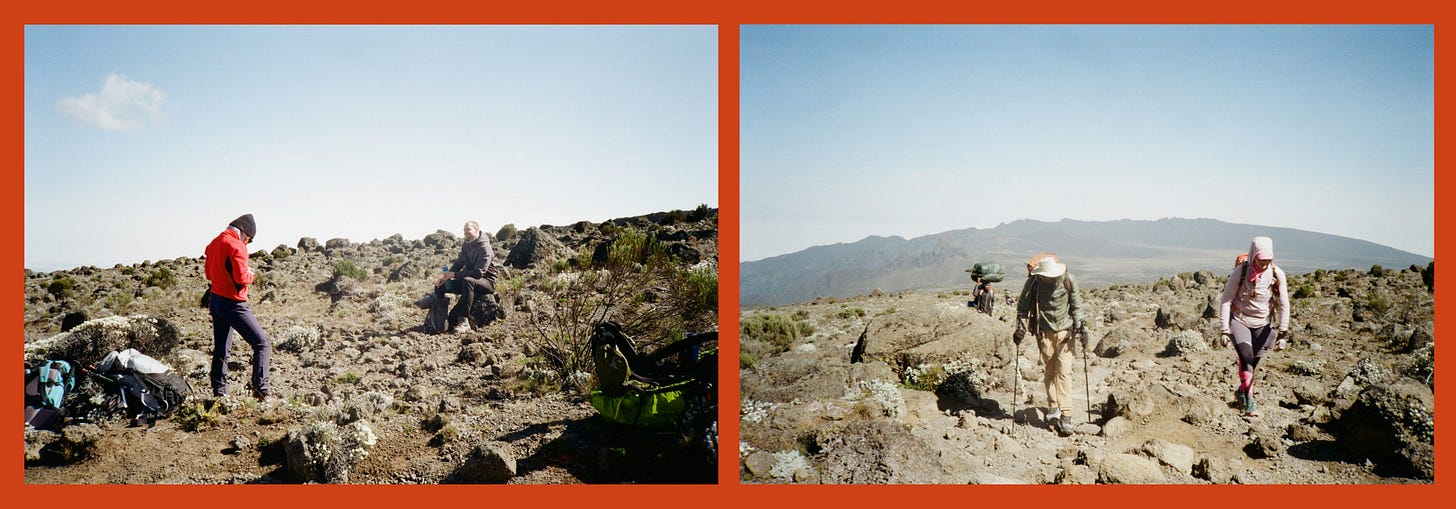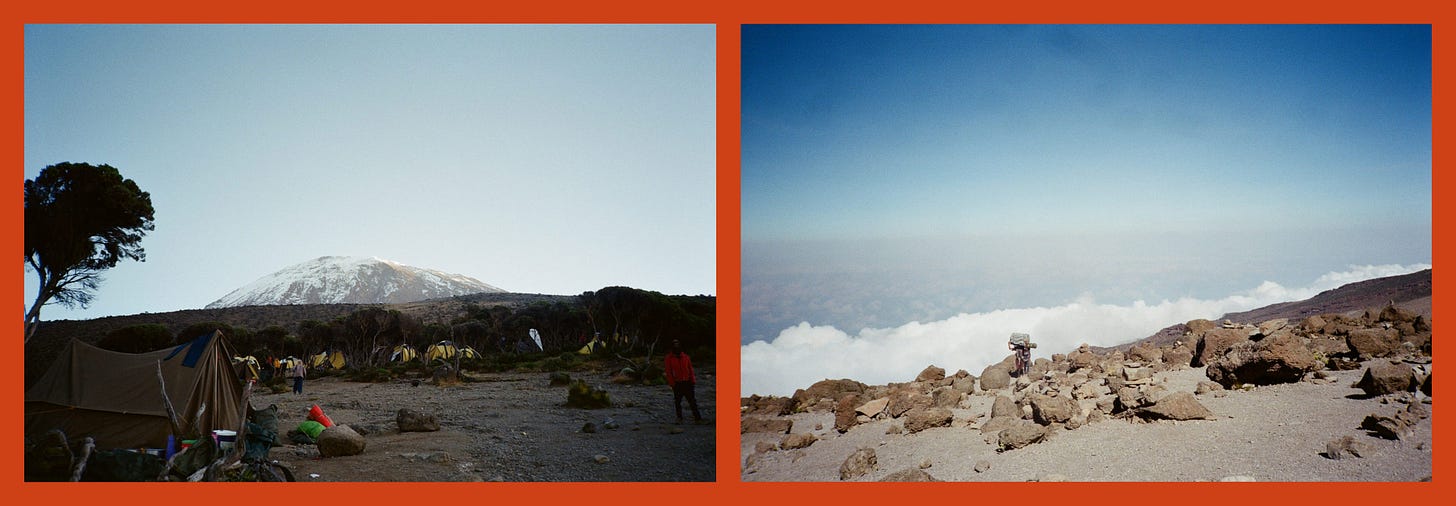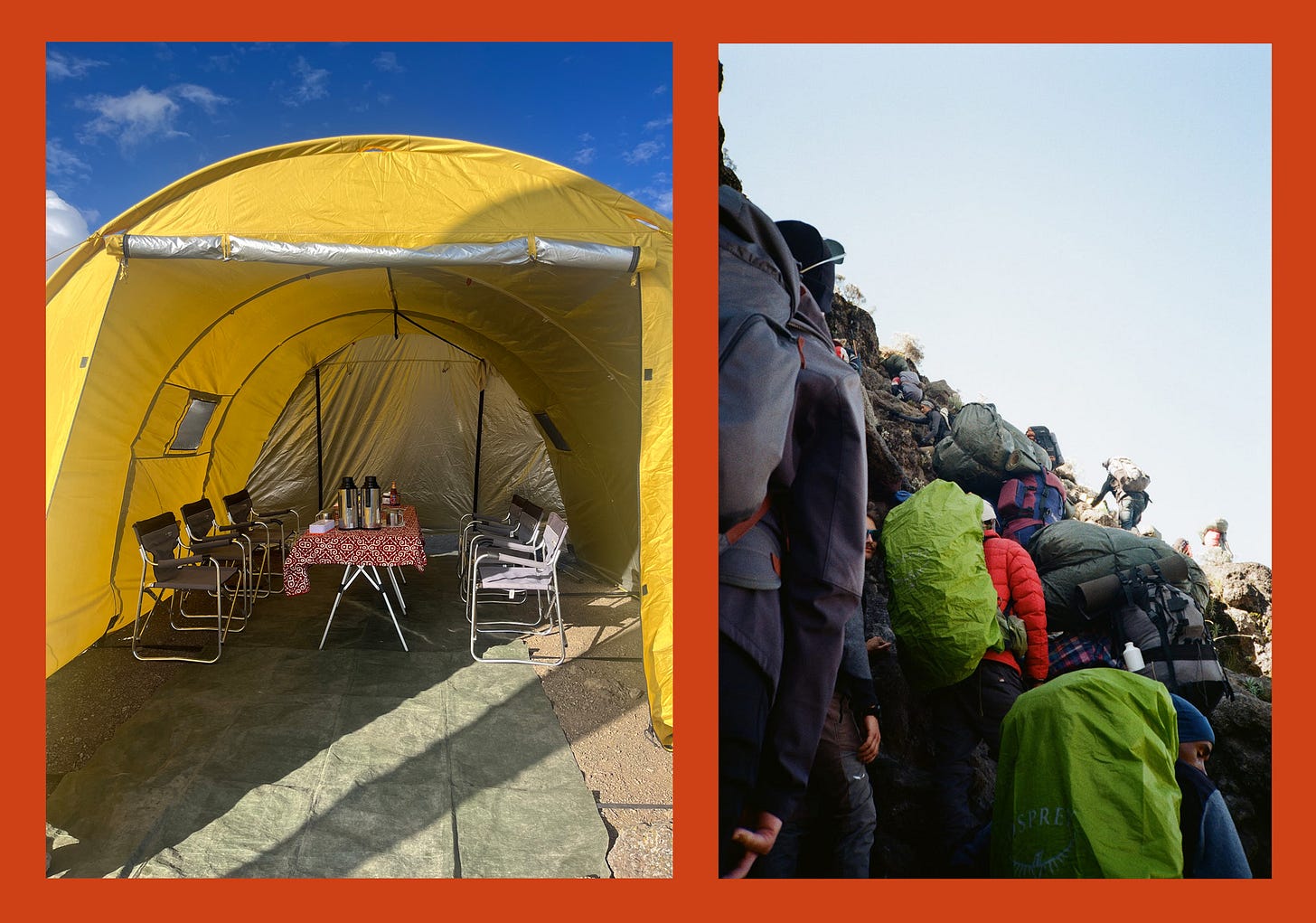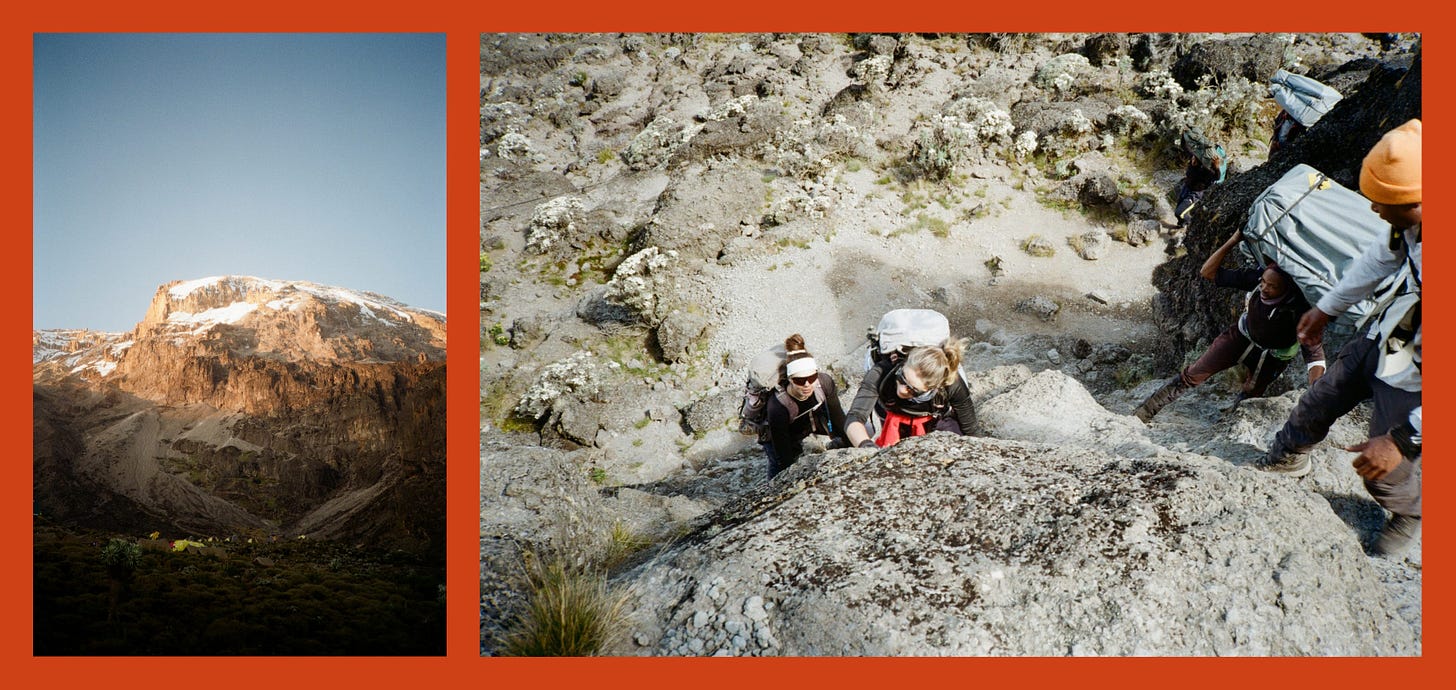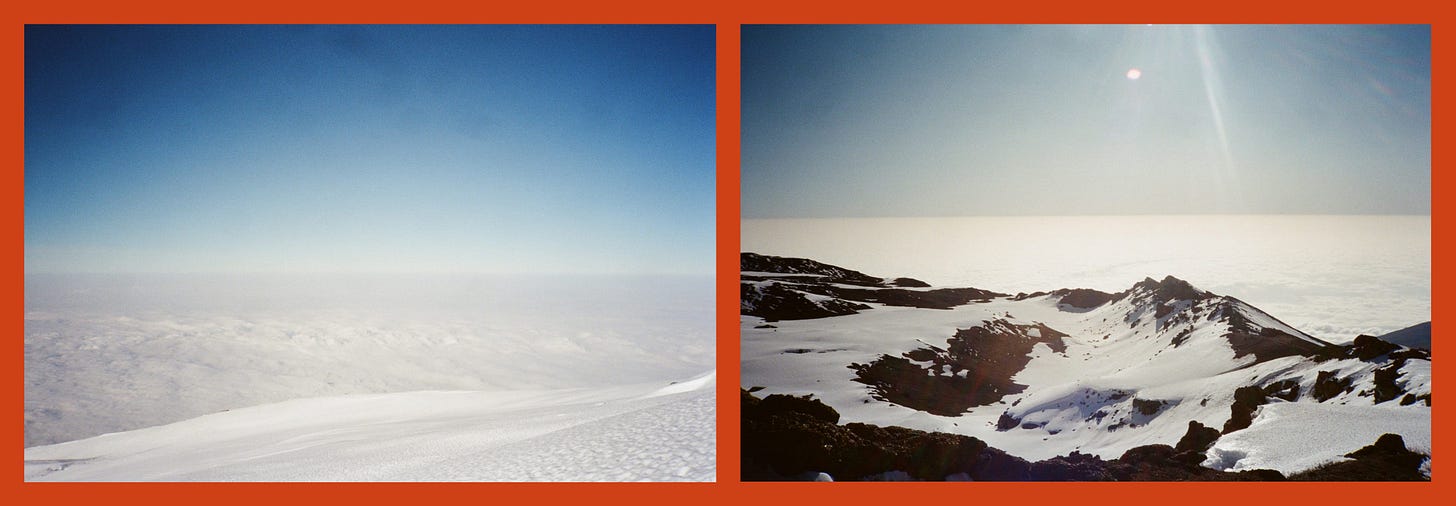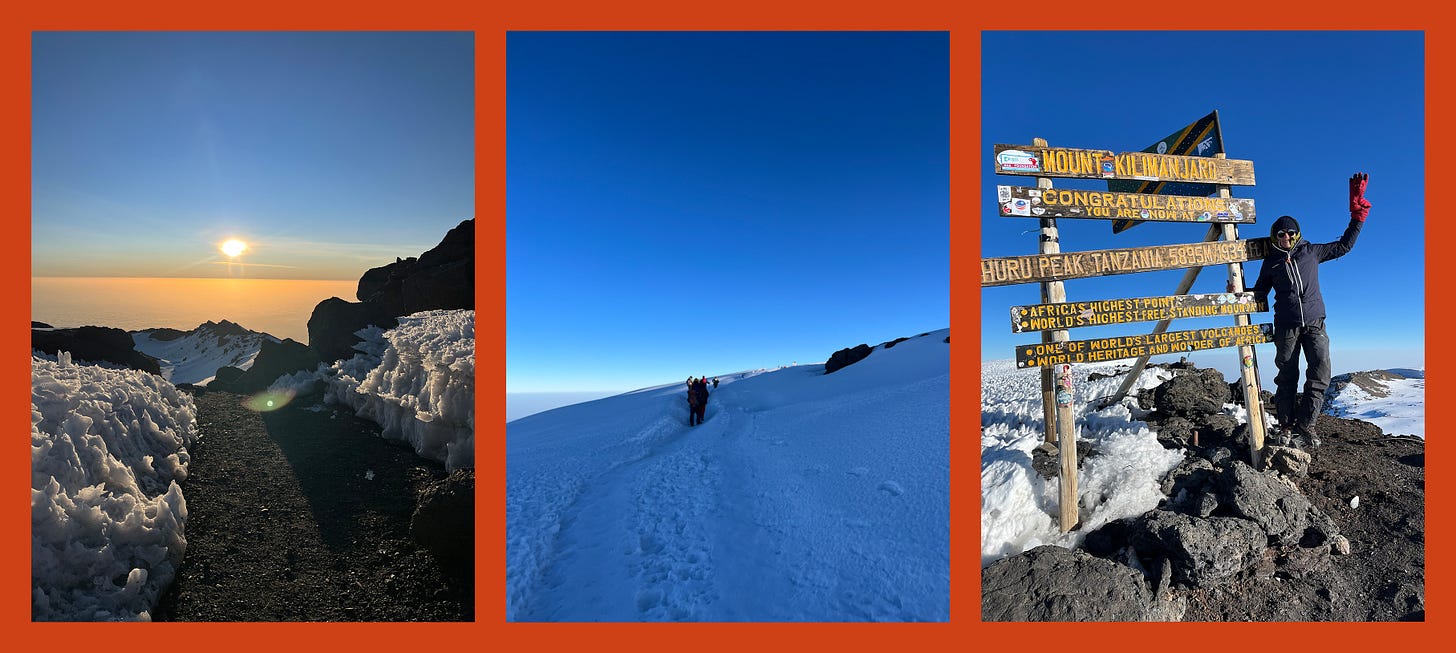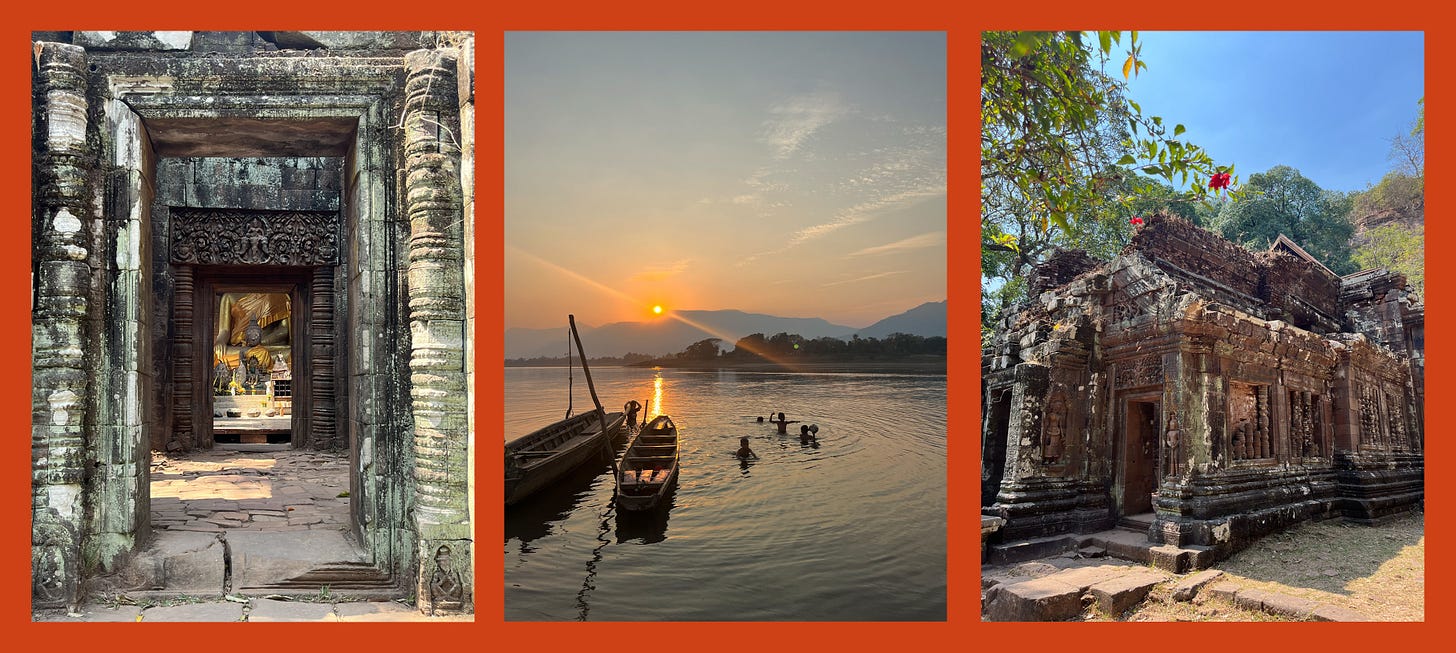A trip to Kilimajaro by Julie Lejeune, Commercial and Marketing Director at Continents Insolites
A trip of a lifetime
Hi dear Internet friends,
I hope you are doing okay. What a week. Devastating news from the United States and well, from the world in general. It’s a sad sign that people would rather elect a criminal who is racist and sexist than a black woman who might have her flaws too, which however are far far away from the ones from Trump. Wednesday was a sad day for the world and for democracy!
On to some more uplifting topics:
I started a little afternoon drinking routine with a really tasty drink called Volée Salto. As I temporarily quit alcohol and coffee two months ago, and now am missing an afternoon thing (which used to be coffee) - I now love this little refreshment. It’s also very easy to do: Mix 5 cl Volée with grapefruit lemonade, lemon juice and grapefruit zeste and ready. I like to add frozen berries on top - voilá.
I love having little daily rituals every day and it reminds me, I am currently reading the newest book “Man kann auch in die Höhe fallen” from one of my favorite authors Joachim Meyerhoff. In this book he is staying with his mom in the country side after a stroke. Every day, without fail, they are having a glass of whiskey on the rocks at the pond at 6pm - I love that.
Now, I want to talk about this edition of the newsletter: Maybe you know the following about me, maybe you don’t. I do love the world of fashion, interior and luxury travel, but I also have a side that loves (a bit) of adventure, experiences that bring your mind and body to the edge of what you think you can do. Experiences I have done so far are an ashtanga yoga teacher training and Vipassana which is a 10-day silence “retreat”. Here is my report of it, a lot of people I admire have done Vipassana, such as the artist Marina Abramovic or BOF founder Imran Amed. I was also going to take on the Santiago di Compostela, which is a hike of about 800 kilometres along the Spanish coast that takes about 4-6 weeks, I don’t remember now. Unfortunately a very outdoorsy camping trip through Norway I did right before that, made me feel like I didn’t want to do another outdoor trip… So I cancelled the Santiago spontaneously, and instead travelled through Italy for six weeks by myself, which was also interesting. My opinion is that it’s a very important and good practise to undertake journeys outside of our comfort zone to grow our mind and spiritual connection with ourselves, whatever that means to an individual.
Julie Lejeune, who I had met as a colleague in my previous job where I was leading one of the global marketing teams and she the French team, had turned into a client of mine when I was freelancing and when she worked at Vestiaire. But from the first coffee we had, she also turned into someone I loved to talk to about the purpose of life and work. Last time we met in Paris, she had left her job and told me that she was going to climb the Kilimanjaro, right after she had ridden the Thai mountains with a motorcycle. It left me very impressed and intrigued. I asked her if she would share her experience of this trip on this newsletter and she said yes. I think sharing more about these kinds of things you can do while taking a break is so great because they don’t necessarily happen in a fashion or art context so often, so I would like to bring this in as a very interesting aspect to lead an inspired life.
Thanks dear Julie, for sharing your experience with us <3
Julie, it’s great to have you. Can you share a bit about yourself?
For over a decade, I’ve been immersed in the fashion industry, beginning my career in the luxury sector at LVMH, where I spent five years in Paris developing new collections. That experience paved the way for my move into e-commerce, joining Zalando in Berlin, and eventually taking on a leadership role in the second-hand market as Head of Germany/UK at Vestiaire Collective. My focus there was on supporting the growth of sustainable fashion through resale, a challenge I found deeply rewarding.
I’m deeply passionate about sports. Whether it's running half marathons, competing in triathlons, or practicing yoga, exercise is a core part of my daily routine. For me, it’s more than just staying fit—it’s about finding balance, building resilience, and pushing myself to new limits. You’ll often find me exercising in the mornings, as it helps me stay focused, make better decisions, and maintain a sense of calm. Most of the time, it’s purely for fun, but I also enjoy setting personal challenges to keep things exciting. I love cultivating a passion for growth, exploration, and self-improvement that drives me every day.
What inspired you to do the big trip on the Kilimanjaro?
Climbing Kilimanjaro has been a dream of mine for over a decade, ever since a former boss shared her incredible experience of summiting the mountain as part of her honeymoon. The idea of taking on this challenge with my future husband really resonated with me; it seemed like the perfect adventure to share together. Surprisingly, I haven’t found anyone yet to join me on this journey!
This year, after making the bold decision to quit my job, I wanted to focus on experiences that truly mattered to me. Kilimanjaro was at the top of my list. I have a passion for learning, pushing my limits, and exploring new places. Climbing Kilimanjaro felt like the ultimate way to step out of my comfort zone, challenge myself, and immerse myself in a breathtaking landscape. It’s a journey that promises not just a physical challenge but also an opportunity for personal growth and discovery.
How many days did you do the trip and how many kilometers did you do each day? Did you do it on your own or with someone else?
The climb to Kilimanjaro lasted 6 days and covered approximately 60 kilometers, with daily distances ranging from 5 to 15 kilometers. While the trek may seem relatively short, the high altitude adds a unique challenge. Mount Kilimanjaro, standing at about 5,895 meters (19,341 feet) above sea level, demands that every step counts. Over those six days, you ascend from around 2,500 meters to nearly 5,800 meters, resulting in a significant elevation gain of 3,300 meters in just four days before descending.
There are eight main routes up Kilimanjaro, each offering its own benefits, such as smoother acclimatization or stunning views. I chose the Lemosho route, opting for a faster 6-day version, which is typically recommended for experienced trekkers or those who have acclimatized beforehand. As a beginner hiker, this was definitely a challenge for me, as the shorter timeframe allowed less time for my body to adjust to the thinner air.
It's important to note that climbing Kilimanjaro solo is no longer permitted; you must go with a guide as mandated by the Kilimanjaro National Park authorities. There are many reputable companies to choose from, each offering various options based on your schedule and budget. I went with Altezza Travel, who provided not only a guide but also a team of porters to help carry our gear and support the local economy. I was part of a diverse group of six fellow trekkers—hailing from Germany, Italy, Canada, Russia, Australia, and France—all in their early 30s, accompanied by an impressive team of 27 porters!
Where do you sleep and what do you eat? Do you have to bring that all with you?
When you embark on your Kilimanjaro adventure with a guided company, you don’t need to worry about bringing your own gear or food. The trekking company provides everything you need, including tents, meals, and drinking water. Each day, a dedicated team of 27 porters is there to ensure your comfort, with specific roles such as a head chef, a drinking water coordinator, and a camp manager, all working together to create a supportive environment for climbers.
Throughout the hike, you'll sleep in tents—either individually or shared with one other person. Each morning, after you leave camp, the crew disassembles your tent, and they set it up again at the next campsite before you arrive. This means the porters actually have to pass you on the trail and get to the next site ahead of you!
Meals are served in a communal tent where all climbers gather, fostering a wonderful atmosphere and camaraderie. The food is crucial for fueling your trek; at high altitudes, you burn significantly more calories—about 5,000 to 6,000 per day compared to the usual 2,500. Staying hydrated is equally important, so expect to drink liters of water and tea throughout the day to help prevent altitude sickness and keep your body functioning well. The chef and water porters play a vital role in keeping your energy levels up and ensuring you’re ready to tackle each new challenge on the mountain.
How did you prepare yourself - mentally and physically? Was it scary to do this on your own?
Preparing for a solo six-day hike naturally came with some anxiety, but overall, the experience turned out to be far less daunting than I anticipated. The key to my confidence was thorough preparation—both mentally and physically. I invested a lot of time gathering feedback, information, and advice from others who had done similar hikes, which helped me feel more secure and ready to face the challenges ahead.
Physical Preparation - Being physically fit was crucial for me. I’ve been training consistently for years, primarily through triathlon, so I was already in decent shape. But for this hike, I wanted to be in peak condition to truly enjoy the journey without unnecessary strain. To achieve that, I intensified my training regime and made a few lifestyle changes. For five months leading up to the hike, I gave up alcohol and smoking entirely. These adjustments helped me arrive at the trail in excellent physical shape, allowing me to focus on the experience rather than the physical toll.
The Challenge of High Altitude - One of the biggest challenges at high altitude is the risk of Acute Mountain Sickness (AMS), which affects everyone regardless of fitness level. AMS occurs when the body struggles to adjust to lower oxygen levels and reduced air pressure at high elevations, especially above 3,000 meters. More than 75% of climbers on Kilimanjaro, for instance, experience AMS in varying degrees. Symptoms range from headaches and nausea to dizziness, fatigue, and even more severe conditions like High Altitude Pulmonary Edema or High Altitude Cerebral Edema.
To mitigate this risk, I knew that just being in shape wasn’t enough. A few weeks before the hike, I headed to the mountains in Chamonix, France, to train in high-altitude conditions. This preparation was essential, as the only real way to combat AMS is to acclimate your body to these environments beforehand.
In the end, the hike was an incredible experience—one that I could fully enjoy thanks to the months of preparation. For me, the takeaway is clear: preparation is everything. Whether it's gathering information, fine-tuning your physical fitness, or acclimatizing to high altitude, the more prepared you are, the better you'll handle the challenges.
What kind of budget do you need to plan in?
When planning a hike like Kilimanjaro, it’s essential to have a clear idea of the budget. Based on my experience, you should plan for a total cost of around €4,000 to €5,000. Here's a breakdown of where that money goes:
1. Flights: €1,500. The cost of flights can vary depending on your location and when you book, but generally, you should allocate around €1,500 for round-trip airfare.
2. The Hike: €1,500 - €2,500. The cost of the hike itself will depend on the length of your trek and the company you choose. Basic packages start at around €1,500, but for higher-quality equipment and additional comforts, like a private tent, WC, and shower tent, the price can rise to €2,500. Safety features, such as having more guides per hiker and carrying oxygen, are also factors that influence the price.
I opted for a company that charged just over €2,000 because they limited the weight each porter could carry to 15 kg, compared to the park’s official limit of 20 kg. This meant hiring more porters, which increased the overall cost. However, it was worth it for me, as it felt more ethical and ensured better conditions for the porters.
3. Equipment: €500 - €1,000. Equipment costs can vary greatly depending on what you already own and what you plan to rent. If you're starting from scratch, you might spend close to €1,000. However, if you can borrow or rent some gear, you could reduce this to around €500.
4. Tips and Donations. It's also important to factor in tips for the crew, as many porters earn as little as $10 a day to carry your gear. While tipping is optional, it’s a common practice to offer a gratuity, and many hikers also choose to make additional donations to support the porters and guides.
In total, expect to spend between €4,000 and €5,000 for the entire experience. It’s a significant investment, but choosing the right company and ensuring proper equipment and support will make the experience smoother, safer, and more enjoyable.
What was the most beautiful part?
The vegetation is changing so much from the jungle to the arid step with deserted scenery. Sometimes you feel you are not on the same planet anymore. Vegetation is also pretty new and diverse vs what you can find in our western world. All along the way you find new types of trees and flowers.
For me, the most incredible element was to be above the clouds for 5 days - seeing this sea of clouds was pretty magical to me. My pleasure was to wake up very early like just before the sunrise, when the camp was still sleeping and walk in nature to observe life slowly starting with the sun.
What was the hardest part? How intense is it and did you always feel safe?
The Hardest Part of the Kilimanjaro Hike is for sure the Summit Night and the Descent.
Overall, thanks to my thorough preparation, most of the Kilimanjaro hike was a pleasure. I didn’t feel any overwhelming pain or pressure and was able to fully enjoy the journey. However, summit night was an entirely different challenge. Summit night is considered the toughest part of the hike. You start the ascent at night to reach the peak by sunrise, but around 3 a.m., as I climbed past 5,200 meters, I began to suffer from a severe migraine. This was likely due to the combination of Acute Mountain Sickness (AMS) and the cold air affecting my sinuses and brain. The pain was intense, and for the remaining four hours of the ascent, I had to rely on mental resilience. I focused on my breathing, tried to calm myself, and managed the headache as best as I could.
Listening to my body was crucial. Since I regularly experience migraines due to stress or fatigue, I had to assess whether this pain was within my normal range or if it was a sign of something more serious, like High Altitude Cerebral Edema (HACE). This was a constant mental balancing act—pushing forward while being mindful of the potential risks.
The Descent: The True Test of Endurance. Surprisingly, the hardest part wasn’t reaching the summit, but the descent. After 7 hours of climbing to the peak, you immediately start a 2-3 hour descent on a different, sandy path. Your body is already exhausted from the climb, and now you have to push through the fatigue to descend back to base camp. The terrain was slippery and challenging, but the main goal was to get to lower altitudes for better oxygen levels as quickly as possible.
In total, summit night took about 10 to 11 hours of continuous physical effort. It was grueling, both mentally and physically, but it was also an unforgettable experience. The key was staying focused, managing the discomfort, and trusting my preparation. Despite the challenges, I always felt safe, thanks to the guides and the safety procedures in place.
While summit night is undeniably intense, it’s manageable with the right mindset and preparation. The hardest part for me wasn’t reaching the top, but making the long descent afterward. Staying mentally strong and listening to your body are crucial to completing this demanding part of the hike.
Do you think you would do it again?
For Kilimandjaro I think it was the last time, but there are so many other summits and adventures around the world, so for sure many more hikes & summits to come !
What’s next for you on your list of adventures? :)
I am already preparing the next hike in Nepal in the Himalaya but getting a bit away from the touristic places and focusing on a region that is less known : the Doplo and Mustang. I am planning to climb the Bhrikuti Peak (6361 m) and other peaks above 5000m, staying in high altitude longer (2 to 3 weeks).
Last question: Which places in the world are your favorite places?
I have lived ever since in Paris or big cities but I am definitely a nature girl so :
Okavango Delta in North Botswana is magical, a safari between the dry land and flooded parts with an incomparable fauna and light - I have never seen such bright colors.
Nuqui, the lost paradise of the Colombian Pacific coast - with 2 flights per week, its black sand and rare connection this is a unique place to live with the rhythm of nature, disconnect and observe whales!
The region of Champassak in Laos, built at the same time as the Angkor temples, with a spectacular architecture, time just stopped there.
Thank you so much for sharing your inspiring journey, Julie! Can’t wait to follow more of your adventures. Bisous!





